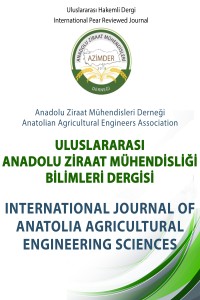Araştırma Makalesi
Yıl 2019,
Cilt: 1 Sayı: 2, 6 - 10, 01.05.2019
Öz
Local sesame genotypes are an important genetic resource for many agricultural and technological features and resistance to disease and insect. The objective of this experiment was to find out seed yield and some yield components of local sesame genotypes grown under field conditions. In this study one registered variety (Hatipoglu) and eleven local genotypes (Akceli, Bivan, Gerger, Gökceköy, Hosmos, Pirag, Sincik, Sögütlübahce, Sutepe-1, Sutepe-2 and Taslıca) were used as plant materials in randomized complete block design with three replications and investigated number of flowering days, physiological maturity days, plant height, number of branches, number of capsules, one thousand seed weight, seed yield and oil content.
It was determined that there were significant differences among the sesame genotypes for physiological maturity days, number of branches,number of capsules and seed yield. The results showed that number of flowering days, physiological maturity days, plant height, number of branches, number of capsules, one thousand seed weight, seed yield and oil content for sesame genotypes ranged between 37 – 39, 98.7 – 113.8, 51.9 – 64.0 cm, 1.5 – 3.5, 12.9 – 37.4, 3.1 – 3.9 g, 43.5 – 51.7 % and 34.9 – 115.4 kgda-1, respectively. The highest seed yield (115.4 kgda-1) was obtained from the Hatipoglu variety, and this variety was followed Hosmos and Gökceköy. The lowest seed yield was obtained from Bivan genotype. Hosmos genotype produces as much yield as standard variety Hatipoglu suggests that this genotype may be promising.
Anahtar Kelimeler
Kaynakça
- Arslan H, Hatipoglu H,Karakus M, 2014. Şanlıurfa Yöresinde Tarımı Yapılan Susam Genotiplerinden Seçilen Bazı Hatların İkinci Ürün Koşullarında Verim ve Verim Unsurlarının Belirlenmesi. Turk J Agric Res, 1: 109-116. (in Turkish).
- Bahkali AH, Hussain MA,Basahy AY, 1998. Protein and oil composition of sesame seeds (Sesamumindicum, L.) grown in the Gizan area of Saudi Arabia. International Journal of Food Sciences and Nutrition, 49: 409-414.
- Baydar H, 2005. Susamda verim, yağ, oleic ve linoleik tipi hatların tarımsal ve teknolojik özellikleri. Akdeniz Üniversitesi Ziraat Fakültesi Dergisi, 18(2): 267-272. (in Turkish).
- Baydar H, Erbaş S, 2014. Yağ Bitkileri Bilimi ve Teknolojisi. Süleyman Demirel Üniversitesi Ziraat Fakültesi, Yayın No: 97, 227-248. (in Turkish).
- Caliskan S, Arslan M, Arioglu H, Isler N, 2004. Effect of planting method and planting populations on growth and yield of sesame in a Mediterranean type of environment. Asian Journal of Plant Sciences, 3(5): 610-613.
- Daniya E, Dadari SA, Ndahi WB, Kuchinda NC, Babaji BA, 2013. Correlation and Path Analysis between Seed Yield and some Weed and Quantitative Components in Two Sesame (Sesamumindicum L.) Varieties as influenced by Seed Rate and Nitrogen Fertilizer. Journal of Biology, Agriculture and Healthcare, 3(15): 12-16.
- El-NakhlawyFS,Shaheen MA, 2009. Response of Seed Yield, Yield Components and Oil Content to the Sesame Cultivar and Nitrogen Fertilizer Rate Diversity.Env.& Arid Land Agric. Sci., 20(2): 21-31.
- El-Sherif AMA, 2016.Sesame (Sesamumindicum L.) Yield and Yield Components Influenced by Nitrogen and Foliar Micronutrient Applications in the Fayoum Region, Egypt. Egypt. J. Agron. 38 (3): 355-367.
- Jamie SD, Langham DR,Wongyai W, 2002. Potential selection criteria for the development of high – yielding determinate sesame varieties. Sesame and Safflower News,17: 29-35.
- Kashani H, Shahab-u-Din, KandhroM N, Ahmed N, Saeed Z, Nadeem A, 2016. Seed Yield and Oil Content of Sesame (Sesamumindicum L.)Genotypes in Response to Different Methods of Nitrogen Application.Indian Journal of Science and Technology, 9(30), DOI: 10.17485.
- KilliF,Tekeli F, 2016. Seed yield and some yield components of sunflower (Helianthus annuusL.) genotypes in Kahramanmaras (Turkey) conditions. Journal of Scientific and Engineering Research,3(4):346-349
- Misganaw M, MekbibF,Wakjira A, 2015. Genotype x environment interaction on sesame (Sesamumindicum L.) seed yield. African Journal of Agricultural Research, 10 (21): 2226-2239.
- Öz M, Karasu A, 2010. Bazısusamçeşitvehatlarının Bursa koşullarında performanslarının belirlenmesi.J. Agric. Fac. HR. U., 14(2): 21-27. (in Turkish).
- Paroda RS, 2013. The Indian oilseeds scenario: Challenges and opportunities. Journal of Oilseeds Research, 30 (2): 11-126.
- SaxenaK,Bisen R, 2017. Line x Tester Analysis in Sesame (Sesamumindicum L.). International Journal of Current Microbiology and Applied Sciences, 6(7): 1735-1744.
- Siva PYVN, Krishna MSR,Yadavalli V, 2013. Correlation, path analysis and genetic variability for economical characteristics in F2 and F3 generations of the cross AVT 3 × TC 25 in Sesame (S.indicum L.).J. Environ. Appl. Biores,1(2): 14-18.
- Tan AŞ, 2011. Bazı Susam Çeşitlerinin Menemen Koşullarında Performansları. Anadolu J. of AARI, 21 (2): 11 – 28. (in Turkish).
- Uzun B, Yol E, Furat S, Topakci M, Canakci M, Karayel D, 2012. The effects of different tillage methods on the post-wheat second crop sesame: seed yield, energy budget, and economic return. Turk J Agric For, 36: 399-407.
- Yol E, Karaman E, Furat Ş, Uzun B, 2010.Assessment of selection criteria in sesame by using correlation coefficients, path and factor analyses. Aust J Crop Sci, 4: 598-602.
Toplam 19 adet kaynakça vardır.
Ayrıntılar
| Birincil Dil | İngilizce |
|---|---|
| Konular | Agronomi |
| Bölüm | Makaleler |
| Yazarlar | |
| Yayımlanma Tarihi | 1 Mayıs 2019 |
| Gönderilme Tarihi | 3 Mart 2019 |
| Yayımlandığı Sayı | Yıl 2019 Cilt: 1 Sayı: 2 |

